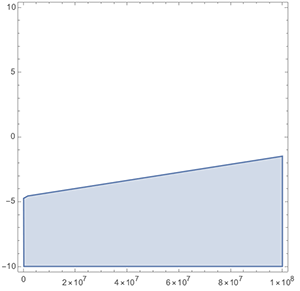Consider this list of inequalities
listCond = {1.72149*10^-17 x1 - 1.85662*10^-10 x2 + 1.34154*10^-9 x3 > 0, 0.0339918 x1 + 0.00037422 x2 - 0.00244772 x3 > 0, 8.91888*10^-11 x1 - 3.22923*10^-7 x2 - 7.94529*10^-7 x3 > 0, 0.0450231 x1 + 0.0684201 x2 + 0.168349 x3 > 0, 1.89778*10^-8 x1 - 0.0000293102 x2 - 0.000177299 x3 > 0, 0.0251657 x1 + 0.0191776 x2 + 0.101373 x3 > 0, 1.51228*10^-17 x1 - 6.09044*10^-10 x2 - 5.12373*10^-10 x3 > 0, 0.0473469 x1 + 0.00463677 x2 + 0.00387406 x3 > 0, 9.43537*10^-10 x1 - 7.24241*10^-6 x2 - 0.0000162489 x3 > 0, 0.0324393 x1 + 0.0351078 x2 + 0.079777 x3 > 0, 5.08188*10^-10 x1 + 6.15116*10^-6 x2 - 1.19815*10^-6 x3 > 0, 0.0532417 x1 - 0.0116377 x2 + 0.00226581 x3 > 0, 3.22738*10^-17 x1 - 1.03283*10^-9 x2 - 4.76066*10^-9 x3 > 0, 0.0171107 x1 + 0.00197426 x2 + 0.00901362 x3 > 0, 1.66869*10^-8 x1 - 0.000033618 x2 - 0.000082661 x3 > 0, 0.0279473 x1 + 0.0381579 x2 + 0.0939938 x3 > 0, 1.89097*10^-18 x1 - 7.63154*10^-11 x2 - 1.50989*10^-10 x3 > 0, 0.0100021 x1 + 0.026301 x2 + 0.0503768 x3 > 0, 6.315*10^-16 x1 - 4.74586*10^-9 x2 - 1.48738*10^-8 x3 > 0, 0.0398816 x1 + 0.0482081 x2 + 0.151094 x3 > 0, 2.96169*10^-10 x1 + 4.84749*10^-6 x2 + 4.78587*10^-7 x3 > 0, 0.00977103 x1 - 0.0106303 x2 - 0.00105459 x3 > 0, 8.56294*10^-10 x1 + 6.8701*10^-6 x2 - 2.95241*10^-9 x3 > 0, 0.0428018 x1 - 0.023279 x2 + 9.41786*10^-6 x3 > 0}
If I ask to RegionIntersection if there is an intersection, I get EmptyRegion[3]
Print[RegionIntersection @@ (ImplicitRegion[#, Evaluate@{x1,x2,x3}] & /@(listCond)) // RepeatedTiming];
(* Out: {0.0092,EmptyRegion[3]} *)
If instead I use FindInstance, I get a solution to the system of inequalities
listCond // FindInstance[#, {x1, x2, x3}, 2] &
(* Out: {{x1 -> 131., x2 -> -0.00789569, x3 -> -0.000611689}, {x1 -> 109., x2 -> 2.17051*10^-6, x3 -> -5.00551*10^-7}} *)
Why is RegionIntersection returning no solution??
Moreover, If I plot the region selected by the inequalities for $x_3=1$ I get a huge region
RegionPlot[listCond /. List -> And /. x3 -> 1, {x1, 0, 10^8}, {x2, -10, 10}]


RegionIntersectionis doing its job. $\endgroup$RegionPlotactually you see a continuous region. I edited the question $\endgroup$